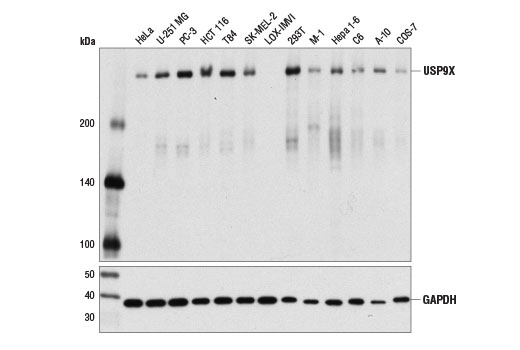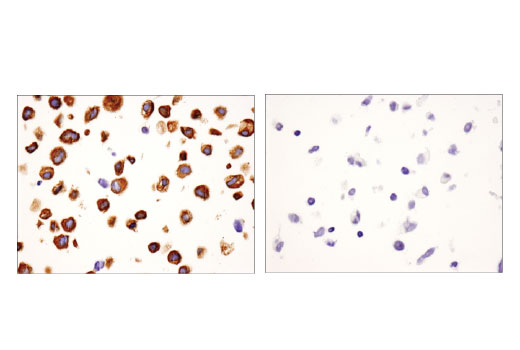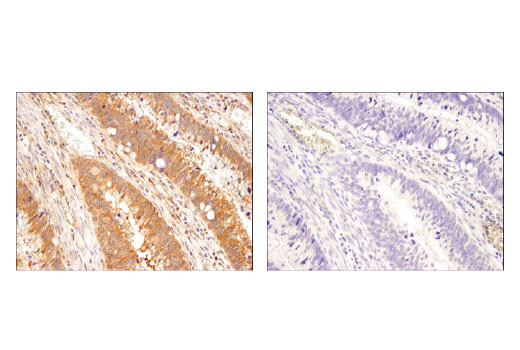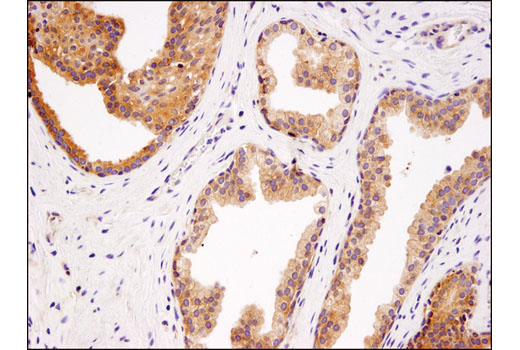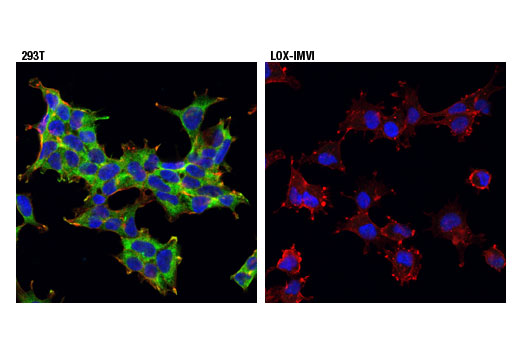WB, IHC-P, IF-IC
H M R Mk
Endogenous
270
Rabbit IgG
#Q93008
8239
Product Information
Product Usage Information
This formulation is ideal for use with technologies requiring specialized or custom antibody labeling, including fluorophores, metals, lanthanides, and oligonucleotides. It is not recommended for ChIP, ChIP-seq, CUT&RUN or CUT&Tag assays. If you require a carrier free formulation for chromatin profiling, please contact us. Optimal dilutions/concentrations should be determined by the end user.
Formulation
Storage
Specificity / Sensitivity
Species Reactivity:
Human, Mouse, Rat, Monkey
Species predicted to react based on 100% sequence homology
The antigen sequence used to produce this antibody shares
100% sequence homology with the species listed here, but
reactivity has not been tested or confirmed to work by CST.
Use of this product with these species is not covered under
our
Product Performance Guarantee.
Bovine, Dog, Horse
Source / Purification
Monoclonal antibody is produced by immunizing animals with a synthetic peptide corresponding to residues surrounding Asn1272 of human USP9X protein.
Background
Protein ubiquitination and deubiquitination are reversible processes catalyzed by ubiquitinating enzymes (UBEs) and deubiquitinating enzymes (DUBs) respectively (1,2). DUBs are categorized into five subfamilies-USP, UCH, OTU, MJD, and JAMM. Ubiquitin-specific protease 9, X-linked (USP9X) possesses a well-conserved catalytic domain with cysteine peptidase activity, which allows for cleavage of ubiquitin and polyubiquitin conjugates. USP9X is the mammalian homolog of the Drosophila fat-facets (faf) gene, which is essential for normal eye development and viability of the early fly embryo (3,4). While USP9X expression is also critical for normal mammalian development (5-7), many of its substrates are only beginning to be elucidated. There is mounting evidence that USP9X functions in the formation of epithelial cell-cell contacts through deubiquitination-dependent stabilization of molecules involved in maintaining the integrity of both adherens and tight junctions. Indeed, USP9X has been found to associate with AF-6, the β-catenin-E-cadherin complex, and EFA6 (8-11). Research studies have also demonstrated that USP9X is an integral component of the TGF-β/BMP signaling cascade by opposing TRIM33-mediated monoubiquitination of SMAD4 (12). USP9X is overexpressed in a variety of human cancers and contributes to enhanced cell survival, in part, through its ability to deubiquitinate and stabilize the Mcl-1 oncoprotein (13). There is some evidence, however, that suggests the role of USP9X in tumorigenesis is context dependent. Research studies have implicated USP9X in a tumor suppressor role during the early stages of pancreatic ductal adenocarcinoma (PDAC) and in an oncogenic role during advanced stages of PDAC (14,15).
- Nijman, S.M. et al. (2005) Cell 123, 773-86.
- Nalepa, G. et al. (2006) Nat Rev Drug Discov 5, 596-613.
- Huang, Y. et al. (1995) Science 270, 1828-31.
- Huang, Y. and Fischer-Vize, J.A. (1996) Development 122, 3207-16.
- Pantaleon, M. et al. (2001) Mech Dev 109, 151-60.
- Noma, T. et al. (2002) Mech Dev 119 Suppl 1, S91-5.
- Xu, J. et al. (2005) J Neurosci Res 80, 47-55.
- Taya, S. et al. (1998) J Cell Biol 142, 1053-62.
- Taya, S. et al. (1999) Genes Cells 4, 757-67.
- Murray, R.Z. et al. (2004) Mol Biol Cell 15, 1591-9.
- Théard, D. et al. (2010) EMBO J 29, 1499-509.
- Dupont, S. et al. (2009) Cell 136, 123-35.
- Schwickart, M. et al. (2010) Nature 463, 103-7.
- Pérez-Mancera, P.A. et al. (2012) Nature 486, 266-70.
- Cox, J.L. et al. (2014) Cancer Biol Ther 15, 1042-52.
Species Reactivity
Species reactivity is determined by testing in at least one approved application (e.g., western blot).
Applications Key
WB: Western Blotting IHC-P: Immunohistochemistry (Paraffin) IF-IC: Immunofluorescence (Immunocytochemistry)
Cross-Reactivity Key
H: human M: mouse R: rat Hm: hamster Mk: monkey Vir: virus Mi: mink C: chicken Dm: D. melanogaster X: Xenopus Z: zebrafish B: bovine Dg: dog Pg: pig Sc: S. cerevisiae Ce: C. elegans Hr: horse GP: Guinea Pig Rab: rabbit All: all species expected
Trademarks and Patents
Limited Uses
Except as otherwise expressly agreed in a writing signed by a legally authorized representative of CST, the following terms apply to Products provided by CST, its affiliates or its distributors. Any Customer's terms and conditions that are in addition to, or different from, those contained herein, unless separately accepted in writing by a legally authorized representative of CST, are rejected and are of no force or effect.
Products are labeled with For Research Use Only or a similar labeling statement and have not been approved, cleared, or licensed by the FDA or other regulatory foreign or domestic entity, for any purpose. Customer shall not use any Product for any diagnostic or therapeutic purpose, or otherwise in any manner that conflicts with its labeling statement. Products sold or licensed by CST are provided for Customer as the end-user and solely for research and development uses. Any use of Product for diagnostic, prophylactic or therapeutic purposes, or any purchase of Product for resale (alone or as a component) or other commercial purpose, requires a separate license from CST. Customer shall (a) not sell, license, loan, donate or otherwise transfer or make available any Product to any third party, whether alone or in combination with other materials, or use the Products to manufacture any commercial products, (b) not copy, modify, reverse engineer, decompile, disassemble or otherwise attempt to discover the underlying structure or technology of the Products, or use the Products for the purpose of developing any products or services that would compete with CST products or services, (c) not alter or remove from the Products any trademarks, trade names, logos, patent or copyright notices or markings, (d) use the Products solely in accordance with CST Product Terms of Sale and any applicable documentation, and (e) comply with any license, terms of service or similar agreement with respect to any third party products or services used by Customer in connection with the Products.
